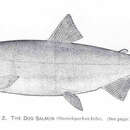Chum salmon (
Oncorhynchus keta), also known as dog salmon, calico salmon or keta salmon, is one of the seven species of Pacific (“true”) salmon (genus
Oncorhynchus). Of all the Pacific salmon,
O. keta has the largest native range, inhabiting the Northern Pacific Ocean, Bering Sea, and further into the Arctic Ocean than its congenitors. As anadromous (migrating between fresh and marine waters) fish, chum salmon spawn in fresh waterways, usually in the lowest parts of streams within 100 km from shore, in rivers from Korea across Russia and Alaska and as historically as far south as central California, although populations no longer spawn south of Northern Oregon. Like pink salmon (
O. gorbuscha), chum hatchings migrate directly into estuaries and ocean waters without feeding and these two species occasionally interbreed; this strategy differs from most other Pacific salmon species which can linger for months in fresh water before heading to sea. Chum spend 3-5 years in ocean waters before returning in summer to early winter, depending on their natal spawning ground. Once back in fresh waters males develop large fangs and very bright red coloration. Adults then die upon spawning (i.e. they are semelparous, spawn only once). Chum reach up 20 kg (although average size is 3-7 kg), and are the second largest Pacific salmon after king salmon (
O. tshawytscha). Until recently chum salmon was the least popular of Alaskan salmon fisheries, as it traditionally fetched a lower price than other salmon. Hatchery releases now make Alaskan runs very productive and
O. keta one of the most valuable fisheries species. As managed under the Pacific Salmon Treaty, all Alaskan chum populations healthy and not overfished. However, of the four “evolutionarily significant units” – which compose Chum genetic diversity in Washington, Oregon and California, two are now protected under the Endangered Species Act under threatened status, and their habitats designated as critical. Initiatives to restore these populations (the Hood Canal Summer Run population and the Lower Columbia River population) are in effect. (
NOAA/National Marine Fisheries Service Fishwatch;
Pacific Salmon Commission;
US Fish and Wildlife Service, Fairbanks fish and wildlife field office;
Washington Department of Fish and Wildlife;
Wikipedia 2012)

